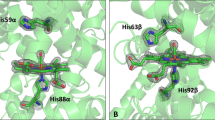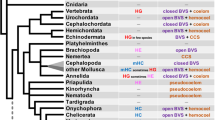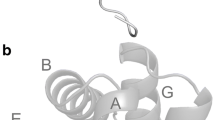Abstract
The cytoplasmic hemoglobin III from the gill of the symbiont-harboring clamLucina pectinata consists of 152 amino acid residues, has a calculated Mm of 18,068, including heme, and has N-acetyl-serine as the N-terminal residue. Based on the alignment of its sequence with other vertebrate and nonvertebrate globins, it retains the invariant residues Phe45 at position CD1 and His98 at the proximal position F8, as well as the highly conserved Trp16 and Pro39 at positions A12 and C2, respectively. The most likely candidate for the distal residue at position E7 is Gln66.Lucina hemoglobin III shares 95 identical residues with hemoglobin II (J. D. Hockenhull-Johnsonet al., J. Prot. Chem. 10, 609–622, 1991), including Tyr at position B10, which has been shown to be capable of entering the distal heme cavity and placing its hydroxyl group within a 2.8 Å of the water molecule occupying the distal ligand position, by modeling the hemoglobin II sequence using the crystal structure of sperm whale metmyoglobin. The amino acid sequences of the twoLucina globins are compared in detail with the known sequences of mollusc globins, including seven cytoplasmic and 11 intracellular globins. Relative to 75% homology between the twoLucina globins (counting identical and conserved residues), both sequences have percent homology scores ranging from 36–49% when compared to the two groups of mollusc globins. The highest homology appears to exist between theLucina globins and the cytoplasmic hemoglobin ofBusycon canaliculatum.
Similar content being viewed by others
References
Arents, G., and Love, W. E. (1990).J. Mol. Biol. 210, 149–161.
Bashford, D., Chothia, C., and Lesk, A. M. (1987).J. Mol. Biol. 196, 199–216.
Bolognesi, M., Onesti, S., Gatti, G., Coda, A., Ascenzi, P., and Brunori, M. (1989).J. Mol. Biol. 205, 529–544.
Bolognesi, M., Coda, A., Frigerio, F., Gatti, G., Ascenzi, P., and Brunori, M. (1990).J. Mol. Biol. 213, 621–625.
Bolognesi, M., Frigerio, F., Lionetti, C., Rizzi, M., Ascenzi, P., and Brunori, M. (1991). InStructure and Function of Invertebrate Oxygen Carriers (Vinogradov, S. N., and Kapp, O. H., eds.), Springer-Verlag, New York, pp. 163–172.
Bonaventura, C., and Bonaventura, J. (1983). InThe Mollusca, Vol. 2, Academic Press, New York, pp. 1–50.
Bordo, D., and Argos, P. (1990).J. Mol. Biol. 211, 975–988.
Bordo, D., and Argos, P. (1991).J. Mol. Biol. 217, 721–729.
Bonner, A. S., and Laursen, R. A. (1977).FEBS Lett. 73, 201–203.
Chan, M. M. S. (1984).Beckman Chromatogr. 5, 2–5.
Childress, J. J., and Fisher, C. R. (1992).Oceanogr. Mar. Biol. Ann. Rev. 30, 35–46.
Como, P. F., and Thompson, E. O. P. (1980).Austr. J. Biol. Sci. 33, 653–664.
Crestfield, A. M., Moore, S., and Stein, W. H. (1963).J. Biol. Chem. 238, 622–627.
Fermi, G., and Perutz, M. F. (1981).Atlas of Molecular Structures in Biology 2: Haemoglobin and Myoglobin, Clarendon Press, Oxford.
Fisher, C. R. (1990).Rev. Aquatic Sci. 2, 399–436.
Fisher, W. K., Gilbert, A. T., and Thompson, E. O. P. (1984).Austr. J. Biol. Sci. 37, 191–203.
Frenkel, M. J., Dopheide, T. A. A., Wagland, B. M., and Ward, C. W. (1992).Mol. Biochem. Parasit. 50, 27–36.
Furuta, H., and Kajita, A. (1983).Biochemistry 22, 917–922.
Furuta, H., and Kajita, A. (1986). InInvertebrate Oxygen Carriers (Linzen, B., ed.), Springer-Verlag, Berlin, pp. 117–121.
Furuta, H., and Kajita, A. (1991). InStructure and Function of Invertebrate Oxygen Carriers (Vinogradov, S. N., and Kapp, O. H., eds.), Springer-Verlag, New York, pp. 257–260.
Garey, J. R., and Riggs, A. F. (1986).J. Biol. Chem. 261, 16,446–16,450.
Garey, J. R., and Thompson, E. O. P. (1985).Austr. J. Biol. Sci. 38, 221–236.
Goodman, M., Branitzer, G., Kleinschmidt, T., and Aschauer, H. (1983)Z. Physiol. Chem. 354, 205–217.
Gross, E., and Witkop, B. (1962).J. Biol. Chem. 237, 1856–1860.
Henrickson, R. I., and Meredith, S. C. (1984).Anal. Biochem. 136, 65–74.
Hockenhull-Johnson, J. D., Stern, M. S., Martin, P., Dass, C., Desiderio, D. M., Wittenberg, J. B., Vinogradov, S. N., and Walz, D. A. (1991).J. Prot. Chem. 10, 609–622.
Honzatko, R. B., Hendrickson, W. A., and Love, W. E. (1985).J. Mol. Biol. 184, 147–164.
Imamura, T., Baldwin, T. O., and Riggs, A. F. (1972).J. Biol. Chem. 247, 2785–2797.
Jones, M. L. (ed.) (1985).Bull. Biol. Soc. Wash. 6, 1–547.
Kemling, N., Kraus, D. W., Wittenberg, J. B., Vinogradov, S. N., Walz, D. A., Hockenhull-Johnson, J. D., Edwards, B. F. P., and Martin, P. (1991).J. Mol. Biol. 222, 463–464.
Konieczny, A., Jensen, E. O., Marcker, K. A., and Legocki, A. B. (1987).Mol. Biol. Rep. 12, 61–66.
Kraus, D. W., and Wittenberg, J. B. (1990).J. Biol. Chem. 265, 16,043–16,053.
Kraus, D. W., Wittenberg, J. B., Lu, J. F., and Peisach, J. (1990).J. Biol. Chem. 265, 16,054–16,059.
Lesk, A. M., and Chothia, C. (1980).J. Mol. Biol. 136, 225–270.
Li, S. L., and Riggs, A. F. (1970).J. Biol. Chem. 245, 6149–6152.
Mann, R. G., Fisher, W. K., Gilbert, A. T., and Thompson, E. O. P. (1986).Austr. J. Biol. Sci. 39, 109–115.
Nagel, R. L. (1985). InBlood Cells of Marine Invertebrates (W. D. Cohen, ed.), Alan R. Liss, New York, pp. 227–247.
Pastore, A., Lesk, A. M., Bolognesi, M., and Onesti, S. (1988).Proteins Struc. Func. Genet. 4, 240–250.
Petruzzelli, R., Goffredo, B. M., Barra, D., Bossa, F., Boffi, A., Verzili, D., Ascoli, F., and Chiancone, E. (1985).FEBS Lett. 184, 328–332.
Petruzzelli, R., Boffi, A., Barra, D., Bossa, F., Ascoli, F., and Chiancone, E. (1989).FEBS Lett. 259, 133–136.
Read, K. R. H. (1966). InPhysiology of Mollusca (Wilbur, K. M., and Yonge, C. M., eds.), Vol. 2, Academic Press, New York, pp. 209–232.
Riggs, A. F., Riggs, C. K., Lin, R. J., and Domdey, H. (1986). InInvertebrate Oxygen Carriers (Linzen, B., ed.), Springer-Verlag, Berlin, pp. 473–476.
Riggs, C. K., and Riggs, A. F. (1990). InInvertebrate Dioxygen Carriers (Preaux, G., and Lontie, R., eds.), Leuven University Press, Leuven, pp. 57–60.
Royer, W. E., Love, W. E., and Fenderson, F. F. (1985).Nature 316, 277–280.
Royer, W. E., Hendrickson, W. A., and Love, W. E. (1989).J. Biol. Chem. 264, 31,052–31,062.
Shishikura, F., Snow, J. W., Gotoh, T., Vinogradov, S. N., and Walz, D. A. (1987).J. Biol. Chem. 262, 3123–3130.
Southward, E. C. (1987). InMicrobes in the Seq (Sleigh, M. A., ed.), Ellis Horwood, Chichester, pp. 84–116.
Suzuki, T., Takagi, T., and Shikama, K. (1981).Biochim. Biophys. Acta 669, 79–83.
Suzuki, T. (1986).J. Biol. Chem. 261, 3692–3699.
Suzuki, T., Takagi, T., and Ohta, S. (1989a)Biochem. J. 260, 177–182.
Suzuki, T., Takagi, T., and Ohta, S. (1989b).Biochim. Biophys. Acta 999, 254–259.
Suzuki, T., and Furukohri, T. (1990).J. Prot. Chem. 9, 69–73.
Takagi, T., Tobita, M., and Shikama, K. (1983)Biochim. Biophys. Acta 745, 32–36.
Takagi, T., Iida, S., Matsuoka, A., and Sikama, K. (1984).J. Mol. Biol. 180, 1179–1184.
Teale, F. W. J. (1959).Biochim. Biophys. Acta 35, 543.
Tentori, L., Vivaldi, G., Carta, S., Antonini, A., and Brunori, M. (1973).Int. J. Pep. Prot. Res. 5, 182–200.
Terwilliger, R. C., and Terwilliger, N. B. (1985).Comp. Biochem. Physiol. 81B, 255–261.
Titchen, D. A., Glenn, W. K., Nassif, N., Thompson, A. R., and Thompson, E. O. P. (1991).Biochim. Biophys. Acta 1089, 61–67.
Wakabayashi, S., Matsubara, H., and Webster, D. A. (1986).Nature 322, 481–483.
Wellner, D., Pannserselvam, C., and Horecker, B. L. (1990).Proc. Natl. Acad. Sci. U.S.A. 87, 1947–1949.
Wittenberg, J. (1985).Bull. Biol. Soc. Washington 6, 301–310.
Wittenberg, J. B., and Kraus, D. W (1991). InStructure and Function of Invertebrate Oxygen Carriers (Vinogradov, S. N., and Kapp, O. H., eds.), Springer-Verlag, New York, pp. 323–330.
Wittenberg, J. B., and Wittenberg, B. A. (1990).Annu. Rev. Biophys. Biophys. Chem. 19, 217–235.
Yegorov, Ts. A., Kazakov, V. K., Shakhparonov, M. I., and Feigina, M. Yu. (1980).Bioorg. Khim. 6, 349–364.
Author information
Authors and Affiliations
Rights and permissions
About this article
Cite this article
Hockenhull-Johnson, J.D., Stern, M.S., Wittenberg, J.B. et al. The amino acid sequence of hemoglobin III from the symbiont-harboring clamLucina pectinata. J Protein Chem 12, 261–277 (1993). https://doi.org/10.1007/BF01028189
Received:
Published:
Issue Date:
DOI: https://doi.org/10.1007/BF01028189




